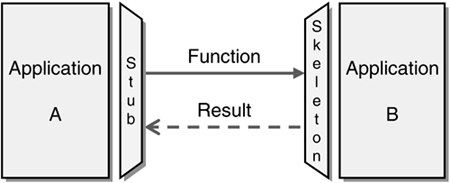- Introduction
- File Transfer
- Shared Database
- Remote Procedure Invocation
- Messaging
Remote Procedure Invocation
by Martin Fowler
An enterprise has multiple applications that are being built independently, with different languages and platforms. The enterprise needs to share data and processes in a responsive way.
How can I integrate multiple applications so that they work together and can exchange information?
How can I integrate multiple applications so that they work together and can exchange information?
File Transfer and Shared Database enable applications to share their data, which is an important part of application integration, but just sharing data is often not enough. Changes in data often require actions to be taken across different applications. For example, changing an address may be a simple change in data, or it may trigger registration and legal processes to take into account different rules in different legal jurisdictions. Having one application invoke such processes directly in others would require applications to know far too much about the internals of other applications.
This problem mirrors a classic dilemma in application design. One of the most powerful structuring mechanisms in application design is encapsulation, where modules hide their data through a function call interface. In this way, they can intercept changes in data to carry out the various actions they need to perform when the data is changed. Shared Database provides a large, unencapsulated data structure, which makes it much harder to do this. File Transfer allows an application to react to changes as it processes the file, but the process is delayed.
The fact that Shared Database has unencapsulated data also makes it more difficult to maintain a family of integrated applications. Many changes in any application can trigger a change in the database, and database changes have a considerable ripple effect through every application. As a result, organizations that use Shared Database are often very reluctant to change the database, which means that the application development work is much less responsive to the changing needs of the business.
What is needed is a mechanism for one application to invoke a function in another application, passing the data that needs to be shared and invoking the function that tells the receiver application how to process the data.
Develop each application as a large-scale object or component with encapsulated data. Provide an interface to allow other applications to interact with the running application.
Develop each application as a large-scale object or component with encapsulated data. Provide an interface to allow other applications to interact with the running application.
Remote Procedure Invocation applies the principle of encapsulation to integrating applications. If an application needs some information that is owned by another application, it asks that application directly. If one application needs to modify the data of another, it does so by making a call to the other application. This allows each application to maintain the integrity of the data it owns. Furthermore, each application can alter the format of its internal data without affecting every other application.
A number of technologies, such as CORBA, COM, .NET Remoting, and Java RMI, implement Remote Procedure Invocation (also referred to as Remote Procedure Call, or RPC). These approaches vary as to how many systems support them and their ease of use. Often these environments add additional capabilities, such as transactions. For sheer ubiquity, the current favorite is Web services, using standards such as SOAP and XML. A particularly valuable feature of Web services is that they work easily with HTTP, which is easy to get through firewalls.
The fact that there are methods that wrap the data makes it easier to deal with semantic dissonance. Applications can provide multiple interfaces to the same data, allowing some clients to see one style and others a different style. Even updates can use multiple interfaces. This provides a lot more ability to support multiple points of view than can be achieved by relational views. However, it is awkward for integrators to add transformation components, so each application has to negotiate its interface with its neighbors.
Since software developers are used to procedure calls, Remote Procedure Invocation fits in nicely with what they are already used to. Actually, this is more of a disadvantage than an advantage. There are big differences in performance and reliability between remote and local procedure calls. If people don't understand these, then Remote Procedure Invocation can lead to slow and unreliable systems (see [Waldo], [EAA]).
Although encapsulation helps reduce the coupling of the applications by eliminating a large shared data structure, the applications are still fairly tightly coupled together. The remote calls that each system supports tend to tie the different systems into a growing knot. In particular, sequencing—doing certain things in a particular order—can make it difficult to change systems independently. These types of problems often arise because issues that aren't significant within a single application become so when integrating applications. People often design the integration the way they would design a single application, unaware that the rules of the engagement change dramatically.
To integrate applications in a more loosely coupled, asynchronous fashion, use Messaging to enable frequent exchanges of small amounts of data, ones that are perhaps used to invoke remote functionality.

